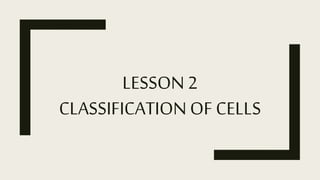
General Biology 1 - Lesson 2 Classification of Cell
- 1. LESSON 2 CLASSIFICATION OF CELLS
- 4. Objectives At the end of this lesson, I will be able to… ■ describe the various ways by which a cell is classified; ■ explain the difference between eukaryotic and prokaryotic cells; ■ compare plant and animal cell; and ■ differentiate multicellular and unicellular organism.
- 5. BasicCell Classification ■ Cells can be classified as: 1. Eukaryotic or Prokaryotic Cell 2.Plant or Animal Cell 3. Unicellular or Multicellular
- 7. Prokaryotes vs. Eukaryotes ■ Biologist recognize two main types of cells, simple prokaryotes and the more complex eukaryotes. ■ The main distinguishing factor between eukaryotes and prokaryotes are the structure housing their DNA.
- 8. Prokayotes ■ It is the first kind of cell to develop about 3.5 billion years ago. ■ Simple organism possessing cells that are smaller in size with simple internal structures.
- 9. Prokayotes ■ Simple life forms such as bacteria, blue-green algae, and archaeans possess the simples cellular components of prokaryotic cell.
- 11. Prokayotes ■ This small size and simple structure allow these organism to reproduce very fast, thus they can exist in great numbers in air, bodies of water, soil, and even inside bodies living hosts.
- 12. Prokayotes ■ Prokaryotic cells has a nucleus which is NOT enveloped by nuclear membrane called nucleoid.
- 13. Prokayotes ■ The prokaryotic cell membrane is compose of phospholipids which serve as a semipermeable barrier to the cells’ outside environment.
- 14. Prokayotes ■ Ribosomes and DNA chromosome are present in the cytoplasm. ■ Many prokaryotes contain plasmids. (additional circular DNA molecules that encode proteins which inactivate antibiotics) ■ Some prokaryotes have cilia and flagella that enable them to move.
- 15. eukaryotes ■ 1.8 billion years ago, a new kind of cell evolved to a larger size and more complex structural components. ■ It can either be unicellular or multicellular.
- 16. eukaryotes ■ Protist, fungi, plants, and animals are all eukaryotes.
- 17. eukaryotes ■ It is also known as true cells and have a well-organized internal condition because of their membrane. ■ They are bigger than prokaryotes and contain more DNA encased with in nucleus, making them capable of more protein production.
- 18. eukaryotes ■ Having organelles is an efficient way to arrange everything that occurs in the cell in order to systemize cellular functions. ■ The cell compartmentalizes cellular processes and organizes its space.
- 20. POINT OF DIFFERENCE EUKARYOTIC CELL PROKARYOTIC CELL NUCLEUS PRESENT ABSENT CELLTYPE USUALLY MULTICELLULAR USUALLY UNICELLULAR EXAMPLE ANIMALS AND PLANTS BACTERIA AND ARCHAEA LYSOSOMES AND PEROXISOMES PRESENT ABSENT MITOCHONDRIA PRESENT ABSENT ENDOPLASMIC RETICULUM PRESENT ABSENT
- 21. POINT OF DIFFERENCE EUKARYOTIC CELL PROKARYOTIC CELL GOLGI APPARATUS PRESENT ABSENT CHLOROPLAST PRESENT ABSENT CELL WALL FOUND IN PLANT CELLS AND FUNGI USUALLY HAS COMPLEX CHEMICAL STRUCTURE VACUOLES PRESENT PRESENT
- 22. PLANT CELL VS ANIMAL CELL
- 23. ORGANELLE ANIMAL CELL PLANT CELL PLASMA MEMBRANE PRESENT PRESENT CYTOPLASM PRESENT PRESENT NUCLEUS PRESENT PRESENT CHLOROPLAST ABSENT PRESENT LYSOSOMES PRESENT IN CYTOPLASM PRESENT (USUALLY NOT EVIDENT) VACUOLE ONE OR MORE SMALL VACUOLE (SMALLER) ONE LARGE CENTRAL VACUOLE CENTRIOLES PRESENT PRESENT ONLY IN LOWER PLANT FORMS
- 24. ORGANELLE ANIMAL CELL PLANT CELL ENDOPLASMIC RETICULUM PRESENT PRESENT RIBOSOMES PRESENT PRESENT MITOCHONDRIA PRESENT PRESENT GOLGI APPARATUS PRESENT PRESENT PEROXISOMES PRESENT PRESENT CELL WALL ABSENT PRESENT (CONSIST OFTHE MATERIAL CELLULOSE)
- 25. CELL WALL ■ In plants, as well as algae, fungi, and bacteria, the cell membrane is surrounded by an additional boundary, a strong cell wall, which is a rigid layer that gives protection, rigid support, and shape to the cell. ■ The cell walls of multiple cells can cling to each other to help support an entire organism.
- 27. UNICELLULARVS. MULTICELLULAR ORGANISM ■ What do amoeba, paramecium and euglena have in common?
- 28. UNICELLULARORGANISM ■ All of the mentioned are bacteria and are unicellular. This means each of them is composed of only single cell. ■ The organism ‘s functions are carried out by collaborative efforts of the different organelles within it. ■ An injury can be detrimental as it can lead to the organism’s death, thus the lifespan of a cellular organism is typically short.
- 29. UNICELLULARORGANISM ■ The reproduction of unicellular organism happens through asexual methods. ■ They have strong abilities for cell division and regeneration. ■ Their mode of nutrition is through phagocytosis, which takes place by engulfing the food.
- 30. MULTICELLULARORGANISM ■ Organisms belonging to the higher forms, such as plants and animals. ■ Their cells are capable of processing nutrition and digestion, and are asked to do roles that depend upon the tissue or organ to which the cells belong. ■ These cells are organized to form complicated structures, such as tissues, organs, and organ systems to complete organism.
- 31. MULTICELLULARORGANISM ■ Injured cells in a multicellular organism are easily replaced through the process of cell division; in this case, the organism is not very much affected.
